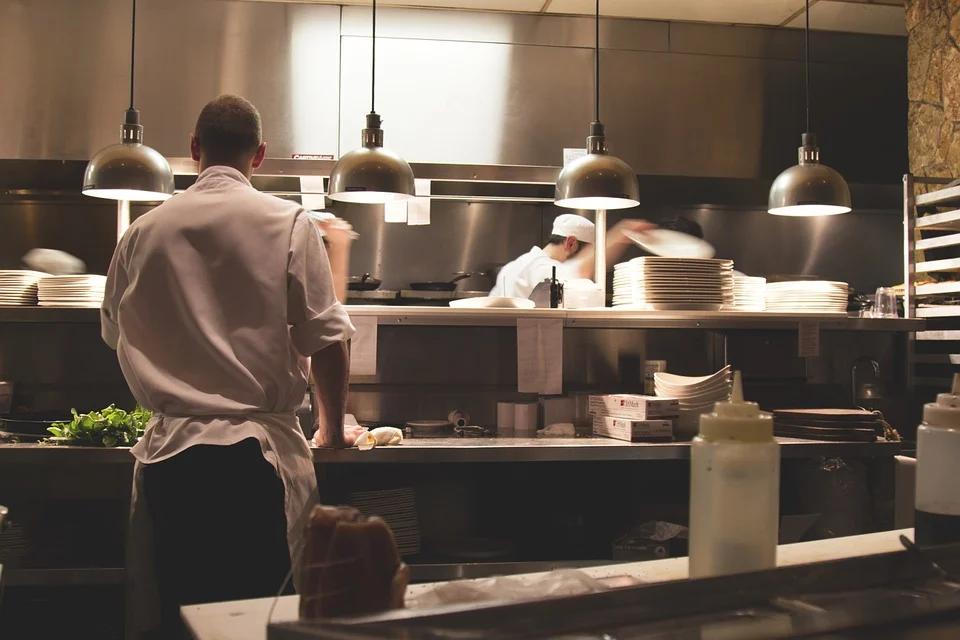A busy schedule at a kitchen usually overlooks kitchen hazards as it becomes more vulnerable to risks, therefore it is necessary that you always keep in mind about the risks involved. This can be achieved by reducing hazards to a minimum number and allowing coworkers to stay safe, work with full efficiency and also provide your guests with top quality service. Risk management is one of the most important factors that needs to be attended to, in order to have a safe kitchen.
Some common kitchen hazards
Some hazards of commercial kitchens are often related to food preparation equipment, handling, the method of storing stock, and finally the cleanliness of the environment. Most of the hazards are created by people.
When work at the commercial kitchen is carried on in accordance with your food handler’s safety training where prevention methods are discussed at regular intervals, hazards can be reduced to a bare minimum. Let us discuss those measures that need to be drawn in order to manage risks of hazards in a commercial kitchen.
A). Manual Handling – Manual handling manoeuvres involves carrying, lifting, and pushing which needs to be done safely otherwise there could be serious harm to the body’s musculoskeletal system.
The health and safety executive reports that over 30% of food and drink industries are mostly musculoskeletal injuries that were caused by manual handling. Some hazardous manual handling tasks include –
- Lifting boxes and crates of food.
- Pushing or pulling wheeled trolleys.
- Carrying pots or stacks of plates.
- Moving equipment.
- Handling containers of drinks.
- Unloading food and drink deliveries.
- Cutting and deboning meat and poultry
Reaching for items on shelves or in walk-in fridges.
Maneuvering unbalanced loads with contents that shift like casks and kegs are very risky, as they can move as you adjust your grip on the move to minimise strain.
Ways to minimise manual handling hazards
- Keep the load close to the body with the heaviest side facing yourself.
- Getting a good grip of the load and adopting a stable position.
- Know your limits, by not pushing yourself for heavier loads more than 25kg
- Good posture is very important as a straight back helps in avoiding twists and leaning.
- Clear obstacles or wet patches on the route beforehand.
- Make use of manual handling equipment such as trolleys, key trucks etc by following the instructions.
Manual handling training has to be provided to jobs that involve lifting and carrying which fully cover proper techniques.
B). Slips, trips and falls
Commercial kitchens usually have the risk of numerous slips, falls created by human error, hence others need to focus closely on proper safety practices and housekeeping. Some common slips, trips and fall hazards include:
- Floor contamination like water, sauce, oil and flour spills.
- Wet floors after cleaning.
- Obstructions in walkways include trailing cables, boxes and crates, bins, cleaning equipment.
- Uneven, worn out or torn flooring.
- Using a ladder to reach out to high pantry shelves.
- Standing in a truck while unloading deliveries.
The most important one among these is the floor contaminations, since this is critical because of the fact that there is continuous movement of feet while transporting hot food that could spill and create hazards.
Commercial kitchens should follow certain rules to minimise slip, fall hazards:
- Good housekeeping should be followed – spillages should be cleaned, obstructions should be moved out of walkways immediately.
- Extra care should be taken while cleaning – while cleaning floors avoid leaving puddles behind. Use the right cleaning material for cleaning floors of the commercial kitchen. Dry mop the kitchen wherever possible to eliminate the risk of slip and fall.
- Report issues with floor or work activities that could be a cause of generating a hazard, for example leaking equipment.
- Keep cables out of walkways, by using the nearest plug socket for appliances.
- Usage of ladders following safety instructions is very important to reduce risks of hazards. Ladders need to rest on level surfaces to have a firm grip while climbing and lifting things. Ensure that you do not carry more than 10 kg weight while on a ladder.
- Avoid using chairs and shelves as they can be unsafe to climb on.
- Carry out deliveries with a co-worker as this can minimise the amount of times you may step on and off the back of a truck and put yourself at risk of falling.
C). Improper storage
If supplies of a commercial kitchen are not stored properly in shelves and fridges, they could fall on people, or food could become unsafe to use over time. Let us evaluate the methods to store supplies correctly.
- Store heavy items not higher than waist height and do not overstock too.
- Use the FIFO food storage system.
- Use a stepladder to access higher shelves so you don’t have to reach for things above your head.
- Follow your food and safety hygiene training.
- Ensure that you store food in the fridge safely, with ready to eat food on the top, raw meat, poultry and fish on the bottom, fruits and vegetables in the bottom drawer. You can keep food in containers for further separation. Do not overload the fridge as it cannot maintain the required temperature.
- Ensure to check “best before and use by dates” on stocks you have stacked on a regular basis.
- Always keep allergenic ingredients well away from non-allergic ones.
- Make sure the temperature of the fridge is between 0-5 degrees C and the freezer is below -18 degrees C.
D). Fire and Electrical Hazards
Since there is a regular usage of electrical equipment and open flames, fire and electricity are serious dangers that can cause burns and shocks or sometimes even ignite a fire. Let us now list a few rules that can help minimize fire and electrical hazards thus finally help in risk management in a commercial kitchen.
- Keep a keen eye out for any sources of ignition and fuel, which means, remove any cardboard boxes, packaging, and flour, to prevent creating a combustible cloud.
- Utmost care needs to be taken when working around naked flames or electric stoves. Remember to keep flammable materials away from the source of heat and remember to wear a suitable chef’s jacket or gloves wherever necessary.
- Regularly check appliances and equipment cables and plugs for signs of any damage such as fraying, dents, cracks, exposed wires, or burn marks, and sometimes unusual sounds while on.
- Clean up any spilled chemicals immediately by using non-flammable materials.
- Use electrical equipment and appliances only for their intended purpose by following the training provided to you at the start.
- Always keep electrical appliances away from water and never overload socket outlets.
- Never try to repair electrical equipment yourself, as it could create further damage. Report the non-working of the equipment to a senior officer ASAP.
- Ensure that you turn off all electrical appliances, stoves and ovens at the end of each working day and while cleaning.
This set of commercial kitchen hazards and risk management methods are far from exhaustive, but they definitely give you a good knowledge of preventing the most common dangers you might face on a daily basis and hence increase your awareness. Your mind-set will be in a conscious mode which can help you spot different types of hazards while your commercial kitchen is working.







